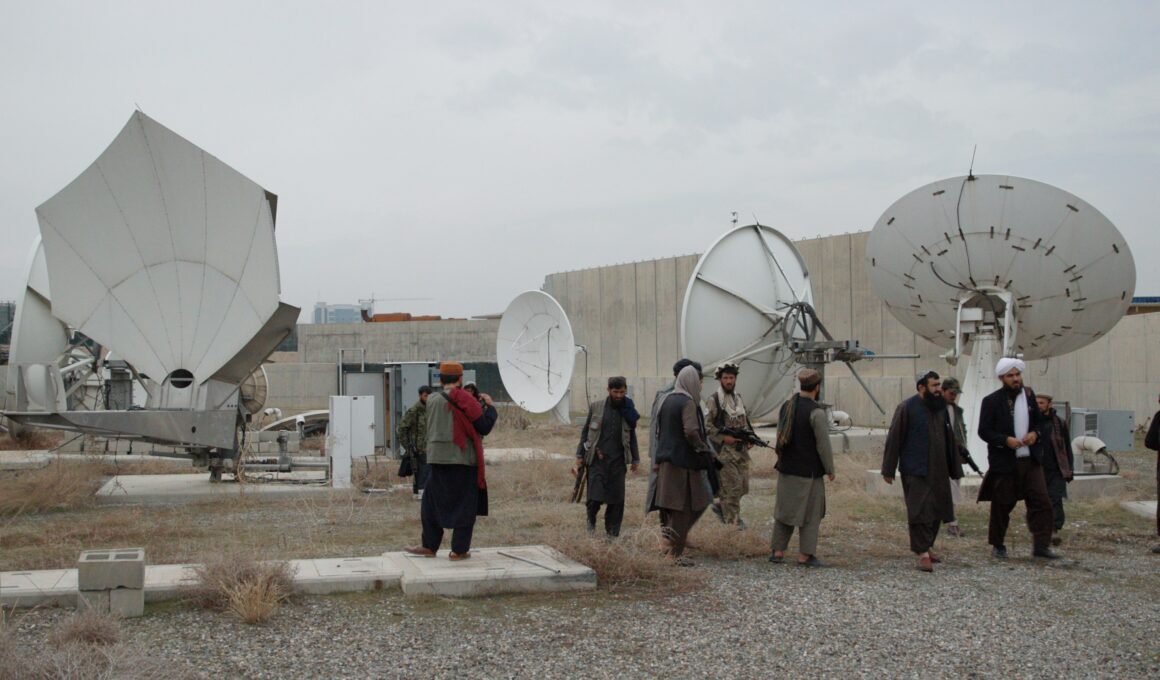A sign at Hollywood Gate, formerly a CIA-run complex in Kabul, Afghanistan, reads, “Today is September 12, 2001,” a reminder that a day prior America was attacked by Osama bin Laden and his al Qaeda terrorist network.
The actual date is nearly 20 years later, and Taliban soldiers are the new occupants who are gazing at the sign while Egyptian journalist Ibrahim Nash’at tags along with a camera while making Hollywoodgate, a documentary film that chronicles what happened after the U.S. pulled out of Afghanistan and left more than $7 billion in weaponry behind.
While a government report blamed both President Donald Trump and President Joe Biden for the chaotic withdrawal that included a suicide bomber killing 13 U.S. service members, Trump continues to blame his successor while campaigning for a return to the White House, making the movie particularly timely.
At a CNN debate four weeks ago, Trump said he had been withdrawing from Afghanistan “with dignity, with strength, with power,” adding that Biden “got out and it was the most embarrassing day in the history or our country’s life.”
In an interview with Newsweek, Nash’at said that he thinks that the past four administrations, beginning with the attack on Afghanistan under President George W. Bush, are ultimately to blame, given his view that the Taliban is stronger now than it was 20 years ago, prior to the invasion.
But the film eschews American politics and focuses strictly on what Nash’at was allowed to capture with his camera, which was primarily pointed at Mawlawi Mansour, the head of the Afghan air force who took up residence at Hollywood Gate and was tasked with overseeing the repair of dozens of helicopters, fighter jets and bombers left behind.
In a rare scene of unintentional levity, Mansour is attempting to create a budget for he and his men, and he reveals that, despite his rank, he’s comically uneducated.
“What’s the monthly cost for 67 people?” he asks.
“100 Afghani per month,” an underling responds.
“Can you multiply 67 by 100?” Mansour asks
As one man stares at his smartphone, another chimes in with: “210,000.”
Another man says, “67,000.”
“All right,” Mansour says, settling on a number that is inflated by a factor of 10.
In another scene, Mansour boasts of marrying a medical doctor, but only after she agreed to give up her practice. In another, he explains to some of his men the importance of women wearing a veil: An unveiled woman is akin to an unwrapped piece of chocolate falling to the floor because no man would want to eat it, he says in his native language as subtitles reveal the conversation.
But the substantial lack of freedom afforded to women under Taliban rule is but a sidebar to the main event: the high-tech weaponry the Taliban suddenly possessed courtesy of the American withdrawal of troops.
“The Americans left us an enormous treasure,” Mansour says—not in an interview as there are none in the movie—but to a group of his men as they tour Hollywood Gate.
Addressing the troops, Mansour says, “You have defeated American and NATO forces. God has granted us victory because of your bravery, and because of our martyrs and suicide bombers.”
The filmmaker also accompanies Mansour and others to a cave where they once hid.
“We used to come here secretly with just one weapon; not even able to switch on a light so the Jews wouldn’t detect us. It’s true,” he says.
“Hey Jews, you lost your war,” a man says.
Back at Hollywood Gate, Mansour and his posse are reviewing gigantic radar and satellite dishes.
“They had such advanced radar, no?” he says. “Could our engineers reconnect them?”
“Yes, they could,” he’s informed.
“The containers of weapons is over there. Don’t show it to the filmmaker.”
They tour the Hollywood Gate gym and marvel that “they even left sports vitamins.”
“We must use this gym to train our soldiers,” says Mansour, before asking that some of the equipment be brought to his quarters because, “I need something that makes my belly smaller.”
A mechanic explains that the Americans cut 15 cables in every plane left behind, but that they also left the parts needed to repair them, and they found “millions of liters of fuel.”
When a group is watching a news woman on television with her face covered, a man complains that Nash’at “rushed to film the face covering. He always does that. Son of a donkey!”
The movie also focuses some on Lt. M.J. Mukhtar, who is shown firing a rifle at a target in the desert while others cover their ears.
“It hits the target very well,” he says. “Where is the setting for burst-fire mode?” he asks before figuring it out and firing machine-gun style.
“The Kalashnikov was heavy, but these are very light,” he says. “Made in the USA,” another man responds.
At one point, Mansour tells a group about the day the Americans killed his father.
“There were spies who reported that I, the Mawlawi, passed by,” he says, describing how he rode a motorcycle toward his mosque because it made for a smaller target than a car.
“So they dropped their bombs,” he says. “Around 18 civilians were martyred. Women, kids and elders. Not a single Talib was hit.”
Afterwards, a Taliban soldier asks why a man with a camera is allowed in the room.
“If his intentions are bad, he will soon die,” Mansour responds.
Later, a man says: “That little devil is filming. I hope he doesn’t bring shame on us. I hope he doesn’t bring us shame in front of China.”

The Taliban first came to power in Afghanistan in 1996, repressing women and outlawing entertainment and recreation while publicly flogging dissidents and lawbreakers, executing some in stadiums.
It also allowed Osama bin Laden to move his Al-Qaeda headquarters there, setting the stage for a U.S. invasion after the terrorist group used American passenger planes to attack New York and Washington on September 11, 2001. The Taliban quickly fell to U.S. military might but retook control of the country 20 years later.
The last American soldiers left Afghanistan on August 30, 2021, leaving behind what the Pentagon said was more than $7.21 billion in war-making equipment
Arranging for access to the Taliban as they discovered, repaired and learned to use the high-tech trove was no easy task, said Nash’at, 34.
He said his producer, Talal Derki, arranged for him to meet with a “fixer” to secure a meeting with a Taliban leader and he hired a Talib translator. The fixer eventually cut off communications, but Hash’at flew to Kabul, regardless.
He had been there weeks, spending money without shooting any film. He was nearly tapped out when his translator suggested he film his cousin. That effort led to Lt. Mukhtar inside Hollywood Gate.
Several meetings later, each one with a higher ranking official than the last, Nash’at was finally ‘interrogated” by Mansour, who granted him permission to film while also threatening him with death should he step out of line.
Nash’at is even allowed to witness the planning of some operations against nearby insurgents, though he’s made to stay outside of the targeted building where Mansour’s men capture and kill their enemies.
Mansour talks of his desire to attack a province in Tajikistan. “Their alliance with Russia is the problem. But they are stuck now in the Ukraine war. They have become cursed,” he says as others laugh.
When he complains that medicine left behind wasn’t used for his men prior to the expiration date, a man says, “Our head doctor is lazy.”
The climax, presumably for Mansour, at least, is a scene Nash’at filmed his last day with the Taliban about a year after he first embedded himself with the group. It was a military parade with dignitaries from Russia, China and Iran in attendance.
After myriad vehicles and tanks, and the “suicide bombing brigade” ride by the attendees, it’s time for the parade’s finale: the American planes that were repaired and are now piloted by Mansour’s troops, flying across the sky as attendees applaud and nod in approval.
“What I tried to show, is what I saw,” Nash’at says in English near the film’s conclusion. “Because I held this camera, I was kept away from the daily suffering of the Afghans. Yet I feel it everywhere I go.”
Nash’at told Newsweek he spent seven months with the Taliban over the course of a year, sometimes living at Hollywood Gate, and he shot 220 hours of footage (the film is 91 minutes long). While shooting vide at the parade, he was informed that Afghanistan’s version of the Secret Service was demanding to see his video, so, rather than comply, he left the country hours later.
Due to Afghanistan’s war-torn history, its citizenry “do not have the idea of trust. It doesn’t exist,” he said. “At any second, something could happen that makes them flip. I never felt safe.”
Hollywoodgate has screened at 40 film festivals capturing 9 awards. It opened last weekend at IFC Center in Greenwich Village, New York and opens Friday in Santa Monica, California at the Laemmle Monica Film Center before heading to San Francisco. Plans for a DVD and streaming haven’t been announced.
Uncommon Knowledge
Newsweek is committed to challenging conventional wisdom and finding connections in the search for common ground.
Newsweek is committed to challenging conventional wisdom and finding connections in the search for common ground.







